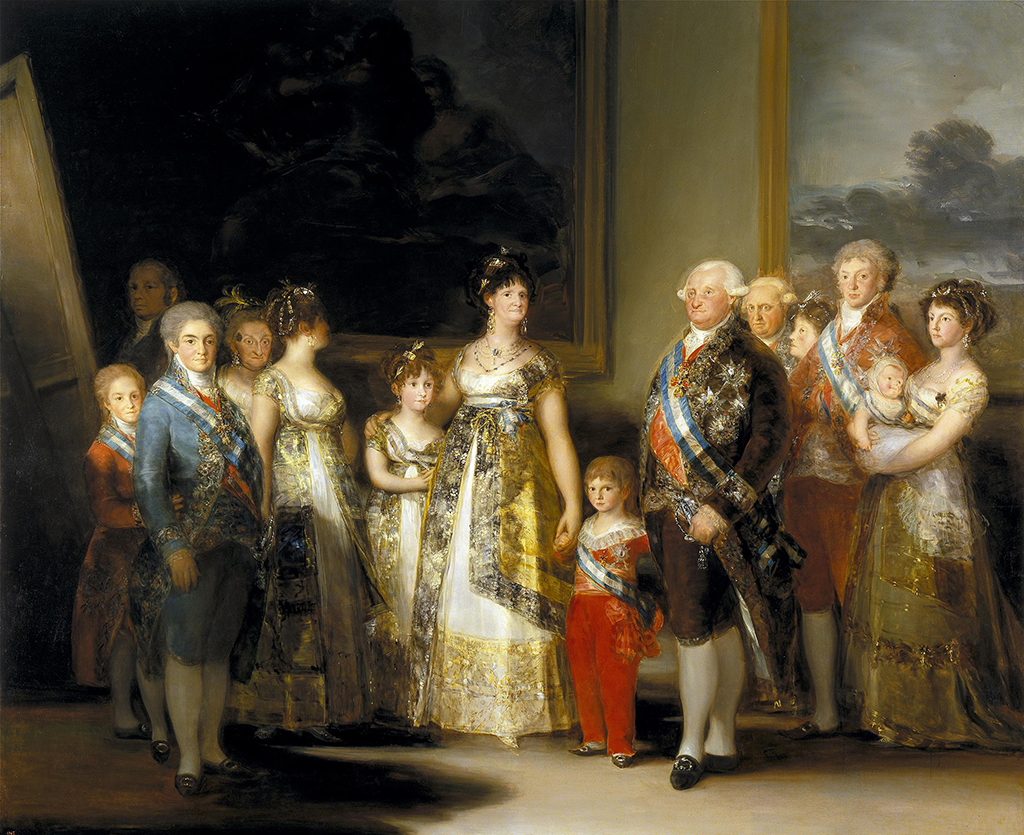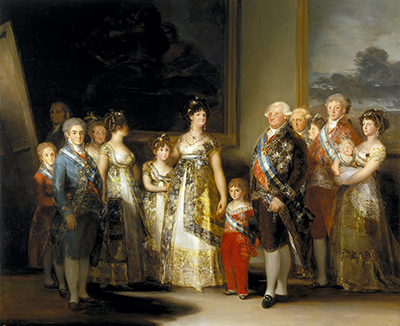By 1786, Goya was serving a court painter in Madrid for Spain's Royal Family. He created portraits of the royals as well as aristocrats. His other royal works included Rococo-style tapestry for the Royal Palace.
Goya was appointed as the Director of the Royal Academy in 1795 and the Primer Pintor de Cámara in 1799, the highest rank for a court painter in Spain. In 1801, Goya painted ‘Charles IV of Spain and His Family’. The oil on canvas painting depicts Charles IV of Spain and various members of his family. Each member of the royal family is dressed in colourful and elaborate costumes and jewelry.
The setting for the gathering is an artist’s studio with a shadowy Goya standing in the left-hand side of the painting.
‘Charles IV of Spain and His Family’ was influenced by Diego Velázquez’s ‘Las Meninas’, a complex composition with Infanta Margaret Theresa and her entourage. Figures include maids of honour, a chaperon, a bodyguard, a dog, and two dwarves. Like Goya’s painting, a figure of Velázquez is in the painting.
In ‘Las Meninas’, the artist is shown painting a large canvas. Unlike ‘Las Meninas’, Goya’s ‘Charles IV of Spain and His Family’ does not feature the same warmth and light atmosphere. Instead, the painting illustrates distressed expressions as if the royal family is anticipating disaster. Both paintings are found in Madrid's world-famous Museo del Prado.
Charles IV ruled Spain from 14 December 1788 until his abdication on 19 March 1808 when he was replaced by his son, Ferdinand VII. In addition to Charles IV, other figures in Goya's painting include the monarch's children Carlos Maria Isidro, Maria Josefa, Maria Isabel, Fracisco de Paula, and Maria Luisa with her husband Don Luis de Parma and baby Carlos Luis. The King's wife Maria Luisa of Parma and his eldest son the future Ferdinand VII are also in the painting. Additional members of the royal family on display include the King’s sister Maria Josefa and brother Don Antonio Pascual. A mysterious and unknown future wife of Fernando’s is shown with her darkened face looking away towards large canvases hanging in the background.
Illness left Goya with severe hearing loss in 1793. Deaf and fearful of additional bouts with illness, the artist’s views and outlook on life and humanity became increasingly pessimistic. His work also reflected this change in attitude with darker themes and imagery dominating his paintings and prints. In 1808, the Bourbon dynasty was deposed in Spain by Napoleon and replaced with Napoleon's brother Joseph Bonarparte, who ruled Spain as Joseph I. During the Peninsular War, Goya translated the horrors of the conflict onto his paintings and etchings. Without royal commissions, he became more isolated from life in the Spanish capital.
With increasing despair both mentally and physically, Goya retreated to a villa outside Madrid in 1819. It was there that he created on of his most famous and darkest series, the ‘Black Paintings’. Like many of his paintings and prints, the series of 14 frescos were not commissioned or created for public exhibition. The series was also heavily influenced by the Peninsular War and other conflicts. Disillusioned with political and social developments following the restoration of the Bourbon monarchy in 1813, Goya moved to France in 1824. He died in Bordeaux at the age of 82 in 1828.
Francisco de Goya was one of Spain’s most important and influential artists during the late eighteenth and early nineteenth centuries. The painter and printmaker is often seen as a link between the Old Masters and modern artists. For many of his works, little is known about their meaning since Goya often kept his views to himself. Born in 1746, Goya began studying art at the age of 14 with José Luzán y Martinez. He moved to Madrid and continued his studies with Anton Raphael Mengs.





